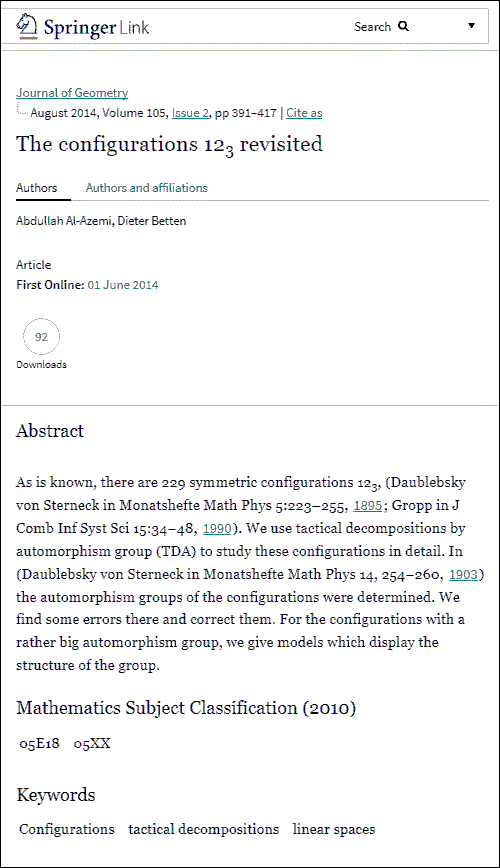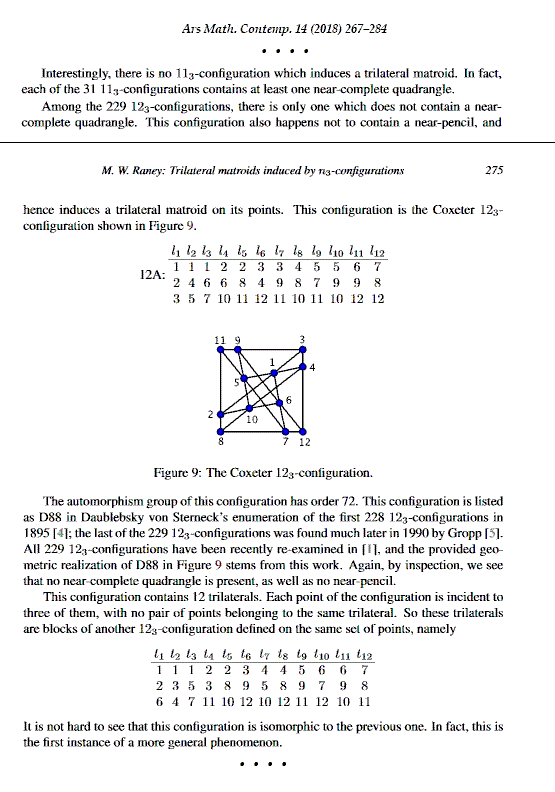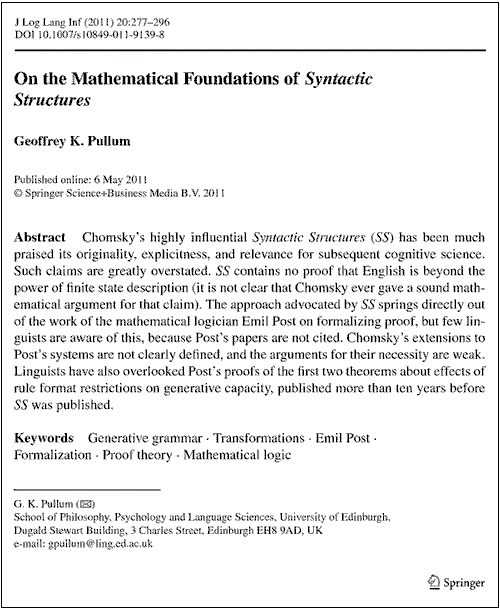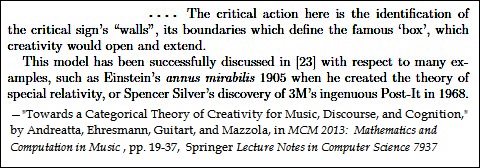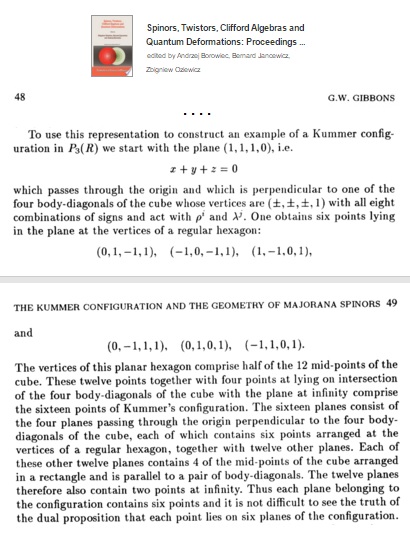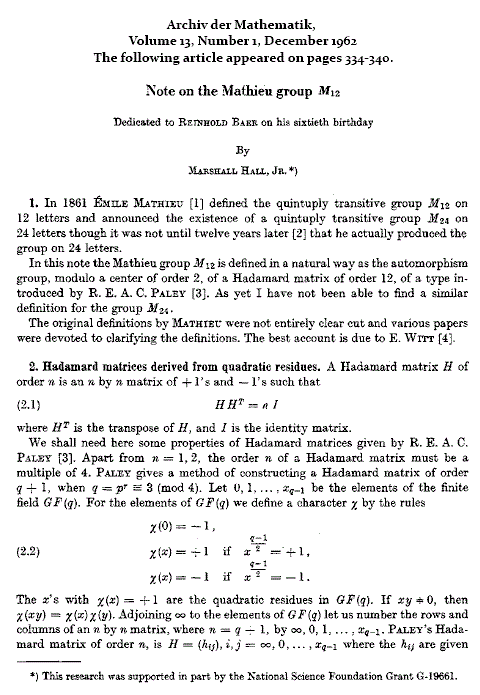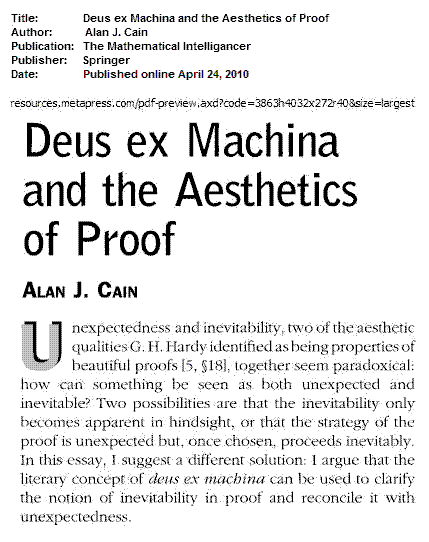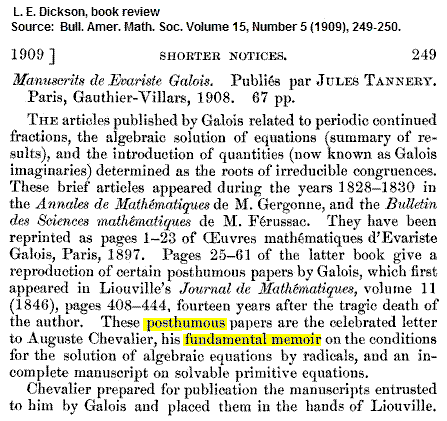Related dark drama —
Thursday, April 27, 2023
Signature Sign-Off
Wednesday, February 8, 2023
Local-Global lnduced Actions
See "Two Approaches to Local-Global Symmetry"
(this journal, Jan. 19, 2023), which discusses
local group actions on plane and solid graphic
patterns that induce global group actions.
See also local and global group actions of a different sort in
the July 11, 1986, note "Inner and Outer Group Actions."
This post was suggested by some remarks of Barry Mazur,
quoted in the previous post, on " Wittgenstein's 'language game,' "
Grothendieck, global views, local views and "locales."

Further reading on "locales" — Wikipedia, Pointless topology.
The word "locale" in mathematics was apparently* introduced by Isbell —
ISBELL, JOHN R. “ATOMLESS PARTS OF SPACES.”
Mathematica Scandinavica, vol. 31, no. 1, 1972, pp. 5–32.
JSTOR, http://www.jstor.org/stable/24490585.
* According to page 841 of . . .
Johnstone, P. (2001). "Elements of the History of Locale Theory."
Pp. 835–851 in: Aull, C.E., Lowen, R. (eds) Handbook of the
History of General Topology, Vol 3. Springer, Dordrecht.
Saturday, January 14, 2023
Châtelet on Weil — A “Space of Gestures”
|
From Gilles Châtelet, Introduction to Figuring Space Metaphysics does have a catalytic effect, which has been described in a very beautiful text by the mathematician André Weil: Nothing is more fertile, all mathematicians know, than these obscure analogies, these murky reflections of one theory in another, these furtive caresses, these inexplicable tiffs; also nothing gives as much pleasure to the researcher. A day comes when the illusion vanishes: presentiment turns into certainty … Luckily for researchers, as the fogs clear at one point, they form again at another.4 André Weil cuts to the quick here: he conjures these 'murky reflections', these 'furtive caresses', the 'theory of Galois that Lagrange touches … with his finger through a screen that he does not manage to pierce.' He is a connoisseur of these metaphysical 'fogs' whose dissipation at one point heralds their reforming at another. It would be better to talk here of a horizon that tilts thereby revealing a new space of gestures which has not as yet been elucidated and cut out as structure. 4 A. Weil, 'De la métaphysique aux mathématiques', (Oeuvres, vol. II, p. 408.) |
For gestures as fogs, see the oeuvre of Guerino Mazzola.
For some clearer remarks, see . . .
Illustrations of object and gestures
from finitegeometry.org/sc/ —
Object
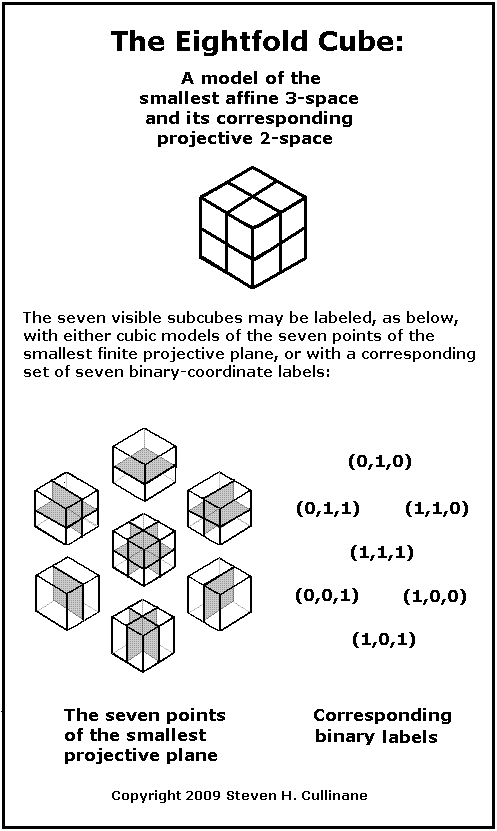
Gestures
An earlier presentation
of the above seven partitions
of the eightfold cube:
|
|
Related material: Galois.space .
Sunday, October 23, 2022
Mathematical Intelligencer News
For Pekonen in this journal, see
From the Finland Station (25 April 2022).
See as well an obituary from Finland.
Saturday, October 8, 2022
For Fans of Religious Lunacy … The Firebird Date
("Raiders of the Lost Spell" continues.)
The above flashback to a 2002 post was suggested by a search in
this journal for "Firebird" that yielded, as the only result . . .
http://www.amazon.com/
Witch-Seldom-Firebird-Nancy-Springer/dp/0142302201/.
That URL connects to The Hex Witch of Seldom at Amazon.com.
That book was reportedly published by Firebird on September 16, 2002,
the date of the above Log24 post.
Thursday, July 21, 2022
Siamese Combinatorial Remarks

Further combinatorial properties* of 24261120 may
be investigated with the aid of a 9×9 square grid, and
perhaps (eventually) also with its triangular counterpart —
 .
.
* Cap sets, gerechte designs, etc.
Tuesday, October 5, 2021
Halloween 2020
Sunday, June 20, 2021
Saturday, June 5, 2021
Bavarian Scholarship
From my search history tonight —
11:11 PM
Number Theory – BSB Catalog opacplus.bsb-muenchen.de
11:13 PM
Klein's paradox, the icosahedron, and ring class fields | SpringerLink
A resulting quotation —
"Our attempt to explain and motivate is not merely a matter of historical whimsy."
— Harvey Cohn. See also Cohn in the previous post's link to 9/11, 2014.
Sunday, November 8, 2020
Local
“All politics is local.”
— Saying attributed to the late Tip O’Neill
“All time is local.”
— Concept attributed to the late Albert Einstein
Related material —

See also Timequake in this journal.
Monday, October 19, 2020
“Graffiti in the Library of Babel” Continues.
Click on the Wiktionary image for the Babel story.
Click on the Springer.com link for related posts.
Sunday, September 27, 2020
Hex Witch
The new Netflix film “Enola Holmes” is from a book by Nancy Springer.
Also by Springer:
See that title in this journal.
Thursday, September 24, 2020
Ludwig Wittgenstein, P.I. . . .
This post was suggested by a Sept. 24, 2020, article at CrimeReads.com
by Philip K. Zimmerman —
“The Philosopher and the Detectives:
Ludwig Wittgenstein’s Enduring Passion
for Hardboiled Fiction.”
Thursday, August 27, 2020
Sunday, August 23, 2020
Sprechen Sie Neutsch?
Wednesday, May 13, 2020
Adventures in the Book Trade
Click the Springer “train of thought” advertisement below to enlarge.
A line for Stephen King:
“She gets the locomotive, I get the caboose.”
Cover Design: Will Staehle / Unusual Co.
Monday, May 4, 2020
May the Fourth
“This is not the Hartshorne you’re looking for.”

“Reality as a Social Process (1953) developed the ideas
that becoming, or process, is fundamental throughout
reality, and that all the things that become are interrelated.”
— From American National Biography
Related material —
The New York Times obituary of Madeline Faith Kripke
and Nietzsche on “becoming, or process.”
Tuesday, April 28, 2020
Monday, April 20, 2020
Geometry for Poets
From Atomicity and Quanta by James Jeans,
Cambridge University Press, 1926, pp. 55-56 —
| “So far as we can at present conjecture, the investigation of the structure which produces this atomicity appears to be the big problem in the path of the quantum-theory. To conform to the principle of relativity, the new atomicity must admit of expression in terms of the space-time continuum, although we have seen that it cannot be an atomicity of the continuum itself. It may conceivably be an atomicity of its metric properties, such as determine its curvatures. We may perhaps form a very rude picture of it by imagining the curvature of the continuum in the neighbourhood of an atom not to be of the continuous nature imagined by Weyl, but to occur in finite chunks—a straight piece, then a sudden bend, then another straight bit, and so on. A small bit of the continuum viewed through a five-dimensional microscope might look rather like a cubist picture; and, conversely, perhaps a cubist picture looks rather more like a little fragment of the continuum than like anything else.” |
This is, of course, not the “atomicity” of the previous post.
For examples of that atomicity, a concept of pure geometry
rather than of physics, see …
Faure, C. A., and Frölicher, A., “Fundamental Notions of
Lattice Theory,” in Modern Projective Geometry (2000).
(Mathematics and Its Applications, vol 521. Springer, Dordrecht.)
Related art (a “cubist picture”) —
Juan Gris, Fruit Dish and Carafe , 1914
Sunday, February 9, 2020
Hors d’Oeuvre
From the May Day 2016 link above, in "Sunday Appetizer from 1984" —
The 2015 German edition of Beautiful Mathematics , a 2011 Mathematical Association of America (MAA) book, was retitled Mathematische Appetithäppchen — Mathematical Appetizers . The German edition mentions the author's source, omitted in the original American edition, for his section 5.17, "A Group of Operations" (in German, 5.17, "Eine Gruppe von Operationen")—
That source was a document that has been on the Web since 2002. The document was submitted to the MAA in 1984 but was rejected. The German edition omits the document's title, and describes it as merely a source for "further information on this subject area." |
From the Gap Dance link above, in "Reading for Devil's Night" —
“Das Nichts nichtet.” — Martin Heidegger.
And "Appropriation Appropriates."
Sunday, January 26, 2020
Saturday, January 11, 2020
Mathematics or Theology?
Hersh wrote a paper with a title containing the phrase
“The Kingdom of Math is Within You.”
In his memory, see Log24 posts from the date of his death
tagged Inner-Space Variations.
Related literature: Hersh's "Death and Mathematics Poems."

See as well this journal on the above publication date.
Monday, December 30, 2019
Number and Time
(Hat tip for the title to Marie-Louise von Franz.)
Remarks by Metod Saniga from the previous post —
Remarks by Wolfgang Pauli, a friend of von Franz —
"This is to show the world that I can paint like Titian.
[Empty frame with jagged sides]. Only technical details
are missing." — As quoted at Derevianko Group.
Related material (see Oct. 11, 2010) —
Sunday, December 29, 2019
Springer Link
Related reading —
"I closed my eyes and saw the number 137—
so very close to the reciprocal of alpha—
on the chest of the runner in Van Cortlandt Park.
Should I start the story there? "
— Alpert, Mark. Saint Joan of New York
(Science and Fiction) (p. 103).
Springer International Publishing. Kindle edition.
Cover detail:
See as well St. Joan in this journal.
Friday, October 25, 2019
Facettenreiche Gestaltung
On the word Gestaltung —
(Here “eidolon” should instead be “eidos .”)
A search for a translation of the book "Facettenreiche Mathematik " —
A paper found in the above search —
A related translation —

See also octad.design.
Wednesday, October 23, 2019
Tuesday, October 1, 2019
Transylvania Revisited
The previous post suggests . . .
|
Jim Holt reviewing Edward Rothstein's Emblems of Mind: The Inner Life of Music and Mathematics in The New Yorker of June 5, 1995: "The fugues of Bach, the symphonies of Haydn, the sonatas of Mozart: these were explorations of ideal form, unprofaned by extramusical associations. Such 'absolute music,' as it came to be called, had sloughed off its motley cultural trappings. It had got in touch with its essence. Which is why, as Walter Pater famously put it, 'all art constantly aspires towards the condition of music.' The only art that can rival music for sheer etheriality is mathematics. A century or so after the advent of absolute music, mathematics also succeeded in detaching itself from the world. The decisive event was the invention of strange, non-Euclidean geometries, which put paid to the notion that the mathematician was exclusively, or even primarily, concerned with the scientific universe. 'Pure' mathematics came to be seen by those who practiced it as a free invention of the imagination, gloriously indifferent to practical affairs– a quest for beauty as well as truth." [Links added.] |
A line for James McAvoy —
"Pardon me boy, is this the Transylvania Station?"

See as well Worlds Out of Nothing , by Jeremy Gray.
Thursday, June 13, 2019
Sunday, May 26, 2019
Sunday, May 19, 2019
Thursday, May 16, 2019
Saturday, April 20, 2019
Meditation on St. Ursula’s Day
Monday, April 8, 2019
Misère Play
Friday, April 5, 2019
April 1 Omega
From posts tagged Number Art —
From the novel Point Omega —

Related material for
Mathematics Awareness Month —

Also on 07/18/2015 —
Tuesday, January 22, 2019
Iconic Remotivation
From an obituary in yesterday's online New York Times —

Photo credit: Gabriella Angotti-Jones/The New York Times
This journal in the time frame of events leading to the obituary —

On "Wakean Cryptogenetics" —
"… Joyce now disposes of a complex machine thanks to which
any linguistic item culled when reading a book, a magazine,
overhearing a conversation, meditating upon a dream, can find
an actor who will underwrite it . . . ."
— P. 81 in Joyce upon the Void by Jean-Michel Rabaté,
Palgrave-Macmillan, 1991.
An Actor —

Tuesday, December 25, 2018
Simply
|
"So to obtain the isomorphism from L2(7) onto L3(2) we simply
— Sphere Packings, Lattices and Groups , |
Compare and contrast —
This post was suggested by a New York Times headline today —

Wednesday, December 12, 2018
Kummerhenge Continues.
Those pleased by what Ross Douthat today called
"The Return of Paganism" are free to devise rituals
involving what might be called "the sacred geometry
of the Kummer 166 configuration."
As noted previously in this journal,
"The hint half guessed, the gift half understood, is Incarnation."
— T. S. Eliot in Four Quartets
See also earlier posts also tagged "Kummerhenge" and
another property of the remarkable Kummer 166 —
For some related literary remarks, see "Transposed" in this journal.
Some background from 2001 —
Friday, December 7, 2018
The Angel Particle
(Continued from this morning)
"The hint half guessed, the gift half understood, is Incarnation."
— T. S. Eliot in Four Quartets
See also other Log24 posts tagged Kummerhenge.
Monday, December 3, 2018
Thursday, November 22, 2018
Geometric Incarnation
"The hint half guessed, the gift half understood, is Incarnation."
— T. S. Eliot in Four Quartets
Note also the four 4×4 arrays surrounding the central diamond
in the chi of the chi-rho page of the Book of Kells —
From a Log24 post
of March 17, 2012
"Interlocking, interlacing, interweaving"
— Condensed version of page 141 in Eddington's
1939 Philosophy of Physical Science
Monday, September 17, 2018
Saturday, September 15, 2018
Eidetic Reduction in Geometry
|
"Husserl is not the greatest philosopher of all times. — Kurt Gödel as quoted by Gian-Carlo Rota Some results from a Google search — Eidetic reduction | philosophy | Britannica.com Eidetic reduction, in phenomenology, a method by which the philosopher moves from the consciousness of individual and concrete objects to the transempirical realm of pure essences and thus achieves an intuition of the eidos (Greek: “shape”) of a thing—i.e., of what it is in its invariable and essential structure, apart … Phenomenology Online » Eidetic Reduction
The eidetic reduction: eidos. Method: Bracket all incidental meaning and ask: what are some of the possible invariate aspects of this experience? The research Eidetic reduction – New World Encyclopedia Sep 19, 2017 – Eidetic reduction is a technique in Husserlian phenomenology, used to identify the essential components of the given phenomenon or experience. |
For example —
The reduction of two-colorings and four-colorings of a square or cubic
array of subsquares or subcubes to lines, sets of lines, cuts, or sets of
cuts between* the subsquares or subcubes.
See the diamond theorem and the eightfold cube.
* Cf. posts tagged Interality and Interstice.
Sunday, September 9, 2018
Plan 9 Continues.
"The role of Desargues's theorem was not understood until
the Desargues configuration was discovered. For example,
the fundamental role of Desargues's theorem in the coordinatization
of synthetic projective geometry can only be understood in the light
of the Desargues configuration.
Thus, even as simple a formal statement as Desargues's theorem
is not quite what it purports to be. The statement of Desargues's theorem
pretends to be definitive, but in reality it is only the tip of an iceberg
of connections with other facts of mathematics."
— From p. 192 of "The Phenomenology of Mathematical Proof,"
by Gian-Carlo Rota, in Synthese , Vol. 111, No. 2, Proof and Progress
in Mathematics (May, 1997), pp. 183-196. Published by: Springer.
Stable URL: https://www.jstor.org/stable/20117627.
Related figures —
Note the 3×3 subsquare containing the triangles ABC, etc.
"That in which space itself is contained" — Wallace Stevens
Monday, August 27, 2018
Geometry and Simplicity
From …
Thinking in Four Dimensions
By Dusa McDuff
"I’ve got the rather foolhardy idea of trying to explain
to you the kind of mathematics I do, and the kind of
ideas that seem simple to me. For me, the search
for simplicity is almost synonymous with the search
for structure.
I’m a geometer and topologist, which means that
I study the structure of space …
. . . .
In each dimension there is a simplest space
called Euclidean space … "
— In Roman Kossak, ed.,
Simplicity: Ideals of Practice in Mathematics and the Arts
(Kindle Locations 705-710, 735). Kindle Edition.
For some much simpler spaces of various
dimensions, see Galois Space in this journal.
Saturday, June 16, 2018
Kummer’s (16, 6) (on 6/16)
"The hint half guessed, the gift half understood, is Incarnation."
— T. S. Eliot in Four Quartets
See too "The Ruler of Reality" in this journal.
Related material —
A more esoteric artifact: The Kummer 166 Configuration . . .
An array of Göpel tetrads appears in the background below.
"As you can see, we've had our eye on you
for some time now, Mr. Anderson."
Monday, May 28, 2018
Skewers
A piece co-written by Ivanov, the author noted in the previous post, was cited
in my "Geometry of the 4×4 Square."
Also cited there — A paper by Pasini and Van Maldeghem that mentions
the Klein quadric.
Those sources suggested a search —
The link is to some geometry recently described by Tabachnikov
that seems rather elegant:
For another, more direct, connection to the geometry of the 4×4 square,
see Richard Evan Schwartz in this journal.
This same Schwartz appears also in the above Tabachnikov paper:


Monday, April 2, 2018
Three Mother Cubes
From a Toronto Star video pictured here on April 1 three years ago:
The three connected cubes are labeled "Harmonic Analysis," 'Number Theory,"
and "Geometry."
Related cultural commentary from a review of the recent film "Justice League" —
"Now all they need is to resurrect Superman (Henry Cavill),
stop Steppenwolf from reuniting his three Mother Cubes
(sure, whatever) and wrap things up in under two cinematic
hours (God bless)."
The nineteenth-century German mathematician Felix Christian Klein
as Steppenwolf —

Volume I of a treatise by Klein is subtitled
"Arithmetic, Algebra, Analysis." This covers
two of the above three Toronto Star cubes.
Klein's Volume II is subtitled "Geometry."
An excerpt from that volume —

Further cultural commentary: "Glitch" in this journal.
Sunday, February 18, 2018
Heuristic Evaluation: A Major Tool
"Heuristic evaluation is a well established method for quickly evaluating
the efficacy of new media solutions to interface issues."
— Neil Gordon et al. , University of Hull
Related material:
Friday, January 19, 2018
Tuesday, December 26, 2017
Raiders of the Lost Stone
Two Students of Structure
A comment on Sean Kelly's Christmas Morning column on "aliveness"
in the New York Times philosophy series The Stone —

Diana Senechal's 1999 doctoral thesis at Yale was titled
"Diabolical Structures in the Poetics of Nikolai Gogol."
Her mother, Marjorie Senechal, has written extensively on symmetry
and served as editor-in-chief of The Mathematical Intelligencer .
From a 2013 memoir by Marjorie Senechal —
|
"While I was in Holland my enterprising student assistant at Smith had found, in Soviet Physics – Crystallography, an article by N. N. Sheftal' on tetrahedral penetration twins. She gave it to me on my return. It was just what I was looking for. The twins Sheftal' described had evidently begun as (111) contact twins, with the two crystallites rotated 60o with respect to one another. As they grew, he suggested, each crystal overgrew the edges of the other and proceeded to spread across the adjacent facet. When all was said and done, they looked like they'd grown through each other, but the reality was over-and-around. Brilliant! I thought. Could I apply this to cubes? No, evidently not. Cube facets are all (100) planes. But . . . these crystals might not have been cubes in their earliest stages, when twinning occurred! I wrote a paper on "The mechanism of certain growth twins of the penetration type" and sent it to Martin Buerger, editor of Neues Jarbuch für Mineralogie. This was before the Wrinch symposium; I had never met him. Buerger rejected it by return mail, mostly on the grounds that I hadn't quoted any of Buerger's many papers on twinning. And so I learned about turf wars in twin domains. In fact I hadn't read his papers but I quickly did. I added a reference to one of them, the paper was published, and we became friends.[5]
After reading Professor Sheftal's paper I wrote to him in Moscow; a warm and encouraging correspondence ensued, and we wrote a paper together long distance.[6] Then I heard about the scientific exchanges between the Academies of Science of the USSR and USA. I applied to spend a year at the Shubnikov Institute for Crystallography, where Sheftal' worked. I would, I proposed, study crystal growth with him, and color symmetry with Koptsik. To my delight, I was accepted for an 11-month stay. Of course the children, now 11 and 14, would come too and attend Russian schools and learn Russian; they'd managed in Holland, hadn't they? Diana, my older daughter, was as delighted as I was. We had gone to Holland on a Russian boat, and she had fallen in love with the language. (Today she holds a Ph.D. in Slavic Languages and Literature from Yale.) . . . . |
Philosophy professors and those whose only interest in mathematics
is as a path to the occult may consult the Log24 posts tagged Tsimtsum.
Saturday, November 4, 2017
Seven-Cycles in an Octad
Figures from a search in this journal for Springer Knight
and from the All Souls' Day post The Trojan Pony —


For those who prefer pure abstraction to the quasi-figurative
1985 seven-cycle above, a different 7-cycle for M24 , from 1998 —

Compare and contrast with my own "knight" labeling
of a 4-row 2-column array (an M24 octad, in the system
of R. T. Curtis) by the 8 points of the projective line
over GF(7), from 2008 —

Thursday, November 2, 2017
The Trojan Pony
From a search in this journal for Springer Knight —


Related material from Academia —
See also Log24 posts from the above "magic" date,
December 4, 2014, now tagged The Pony Argument.
Tuesday, October 3, 2017
Personalized Book Search
Click to enlarge —
The quote from Hermann Weyl on which the above search is based
is from a search within this journal for Springer + Knight.
Monday, October 2, 2017
Springer Link
A check of the second editor of the history of modern algebra
in the previous post yields …
The "first online" date, 13 May 2015, in the above Springer link
suggests a review of Log24 posts tagged Clooney Omega.
Another remark by Parshall, on her home page —
"… and I will brought out the edietd [ sic ] volume, Bridging Traditions:
Alchemy, Chymistry, and Paracelsian Traditions in Early Modern Europe:
Essays in Honor of Allen G.Debus, in 2015 in the Early Modern Studies
series published by the Truman State University Press."
Happy birthday to the late Wallace Stevens.
Tuesday, September 5, 2017
Annals of Critical Epistemology
"But unlike many who left the Communist Party, I turned left
rather than right, and returned—or rather turned for the first time—
to a critical examination of Marx's work. I found—and still find—
that his analysis of capitalism, which for me is the heart of his work,
provides the best starting point, the best critical tools, with which—
suitably developed—to understand contemporary capitalism.
I remind you that this year is also the sesquicentennial of the
Communist Manifesto , a document that still haunts the capitalist world."
— From "Autobiographical Reflections," a talk given on June 5, 1998, by
John Stachel at the Max Planck Institute for the History of Science in Berlin
on the occasion of a workshop honoring his 70th birthday,
"Space-Time, Quantum Entanglement and Critical Epistemology."
From a passage by Stachel quoted in the previous post —

From the source for Stachel's remarks on Weyl and coordinatization —

Note that Stachel distorted Weyl's text by replacing Weyl's word
"symbols" with the word "quantities." —

This replacement makes no sense if the coordinates in question
are drawn from a Galois field — a field not of quantities , but rather
of algebraic symbols .
"You've got to pick up every stitch… Must be the season of the witch."
— Donovan song at the end of Nicole Kidman's "To Die For"
Friday, June 30, 2017
Hurriedly Put Together
The previous post quoted one theologian on a book
by another theologian, saying its tone "is patronizing
and its arguments are hurriedly put together."
For a more leisurely sort of argument, see a 1995* remark
by a mathematician, Ronald Shaw, quoted here on the morning
of Tuesday, June 27, in an update at the end of the previous day's
post "Upgrading to Six" —
". . . recall the notions of Eddington (1936) . . . ."
* In "Finite Geometry, Dirac Groups and the
Table of Real Clifford Algebras," pages 59-99 of
R. Ablamowicz and P. Lounesto (eds.),
Clifford Algebras and Spinor Structures ,
Kluwer Academic Publishers, 1995.
Thursday, April 27, 2017
Road to Hell
An image in the previous post referred to something called
“universal logic,” touted in 2015 by the publisher Birkhäuser*
as a “new interdisciplinary field.”
From this journal on April 20 last year —
Universal Logic and the Road to Hell.
* See the webpage excerpted below.
Wednesday, April 26, 2017
Again
See also "Cornerstone" in this journal and …
A sidebar from a Google search today —

This suggests a review of posts now tagged Obelisk,
which include …
Friday, April 21, 2017
Music Box
Monday, May 23, 2016
Springer
In memory of the late mathematician John Nash
and of the late actor Alan Young ...
A Talking Horse —
What the horse says: "First online: 28 August 2013."
See also Overarching, Psychonauts, and Spider Tale in this journal.
Thursday, May 12, 2016
But Seriously …
Google today released on GitHub an English parser,
Parsey McParseface . From Google Research Blog —
"Today, we are excited to share the fruits of our research
with the broader community by releasing SyntaxNet,
an open-source neural network framework implemented in
TensorFlow that provides a foundation for
Natural Language Understanding (NLU) systems.
Our release includes all the code needed to train new
SyntaxNet models on your own data, as well as
Parsey McParseface , an English parser that we have
trained for you and that you can use to analyze English text."
"While the accuracy is not perfect, it’s certainly high enough
to be useful in many applications. The major source of errors
at this point are examples such as the prepositional phrase
attachment ambiguity described above, which require real
world knowledge (e.g. that a street is not likely to be located
in a car) and deep contextual reasoning. Machine learning
(and in particular, neural networks) have made significant
progress in resolving these ambiguities. But our work is still
cut out for us: we would like to develop methods that can
learn world knowledge and enable equal understanding of
natural language across all languages and contexts."
But seriously …
For some historical background, see (for instance) a book by
Ekaterina Ovchinnikova —
Integration of World Knowledge for
Natural Language Understanding ,
Atlantis Press, Springer, 2012.
A PDF of Chapter 2, "Natural Language Understanding
and World Knowledge," is available for download.
The philosophical background is the distinction between
syntax and semantics . See (for instance) …
Sunday, May 1, 2016
Sunday Appetizer from 1984
Judith Shulevitz in The New York Times
on Sunday, July 18, 2010
(quoted here Aug. 15, 2010) —
“What would an organic Christian Sabbath look like today?”

The 2015 German edition of Beautiful Mathematics ,
a 2011 Mathematical Association of America (MAA) book,
was retitled Mathematische Appetithäppchen —
Mathematical Appetizers . The German edition mentions
the author's source, omitted in the original American edition,
for his section 5.17, "A Group of Operations" (in German,
5.17, "Eine Gruppe von Operationen") —
|
Mathematische Appetithäppchen: Autor: Erickson, Martin —
"Weitere Informationen zu diesem Themenkreis finden sich |
That source was a document that has been on the Web
since 2002. The document was submitted to the MAA
in 1984 but was rejected. The German edition omits the
document's title, and describes it as merely a source for
"further information on this subject area."
The title of the document, "Binary Coordinate Systems,"
is highly relevant to figure 11.16c on page 312 of a book
published four years after the document was written: the
1988 first edition of Sphere Packings, Lattices and Groups ,
by J. H. Conway and N. J. A. Sloane —

A passage from the 1984 document —
Wednesday, April 20, 2016
Symmetric Generation of a Simple Group
The reference in the previous post to the work of Guitart and
The Road to Universal Logic suggests a fiction involving
the symmetric generation of the simple group of order 168.
See The Diamond Archetype and a fictional account of the road to Hell …

The cover illustration below has been adapted to
replace the flames of PyrE with the eightfold cube.
For related symmetric generation of a much larger group, see Solomon’s Cube.
Friday, March 25, 2016
Pleasantly Discursive
Toronto geometer H.S.M. Coxeter, introducing a book by Unitarian minister
Richard J. Trudeau —
"There is a pleasantly discursive treatment of Pontius Pilate’s
unanswered question ‘What is truth?’”
— Coxeter, 1987, introduction to Trudeau’s
The Non-Euclidean Revolution
Another such treatment …
"Of course, it will surprise no one to find low standards
of intellectual honesty on the Tonight Show.
But we find a less trivial example if we enter the
hallowed halls of Harvard University. . . ."
— Neal Koblitz, "Mathematics as Propaganda"
Less pleasantly and less discursively —
"Funny how annoying a little prick can be."
— The late Garry Shandling
Thursday, March 24, 2016
Truth in 1984
"The theory of elliptic curves and modular forms is
one subject where the most diverse branches
of mathematics come together: complex analysis,
algebraic geometry, representation theory, number theory."
— Neal Koblitz, first sentence of
Introduction to Elliptic Curves and Modular Forms,
First Edition, Springer-Verlag, 1984
Related material —
A quote co-authored by Koblitz appears in today's
earlier post The Wolf Gang.
See also The Proof and the Lie.
Tuesday, March 1, 2016
Edifice
"Euclid's edifice loomed in my consciousness as a marvel among
sciences, unique in its clarity and unquestionable validity."
—Richard J. Trudeau in The Non-Euclidean Revolution (1986)
See also Edifice in this journal and last night's architectural post.
Tuesday, February 9, 2016
Cubism
The hexagons above appear also in Gary W. Gibbons,
"The Kummer Configuration and the Geometry of Majorana Spinors,"
1993, in a cube model of the Kummer 166 configuration —
Related material — The Religion of Cubism (May 9, 2003).
Wednesday, January 27, 2016
Game Theory for Steiner
"The definition of easy to learn, hard to master"
— Alex Hern in The Guardian today on the game of Go
Not unlike music, mathematics, and chess.
Thursday, December 3, 2015
Overarching Symmetry
From p. 34 of the preprint "Snapshots of Conformal Field Theory,"
by Katrin Wendland, arXiv, 11 April 2014 —

50. Gannon, T.: Much ado about Mathieu (arXiv:1211.5531 [math.RT])
85. Taormina, A., Wendland, K.: The overarching finite symmetry group
of Kummer surfaces in the Mathieu group M24. JHEP 08, 125 (2013)
86. Taormina, A., Wendland, K.: Symmetry-surfing the moduli space
of Kummer K3s (arXiv:1303.2931 [hep-th])
87. Taormina, A., Wendland, K.: A twist in the M24 moonshine story
(arXiv:1303.3221 [hep-th])
The Wendland paper was published on Jan. 7, 2015, in
Mathematical Aspects of Quantum Field Theories ,
edited by Damien Calaque and Thomas Strobl
(Springer Mathematical Physics Studies), pages 89-129.
Monday, November 23, 2015
Dirac and Line Geometry
Some background for my post of Nov. 20,
"Anticommuting Dirac Matrices as Skew Lines" —
His earlier paper that Bruins refers to, "Line Geometry
and Quantum Mechanics," is available in a free PDF.
For a biography of Bruins translated by Google, click here.
For some additional historical background going back to
Eddington, see Gary W. Gibbons, "The Kummer
Configuration and the Geometry of Majorana Spinors,"
pages 39-52 in Oziewicz et al., eds., Spinors, Twistors,
Clifford Algebras, and Quantum Deformations:
Proceedings of the Second Max Born Symposium held
near Wrocław, Poland, September 1992 . (Springer, 2012,
originally published by Kluwer in 1993.)
For more-recent remarks on quantum geometry, see a
paper by Saniga cited in today's update to my Nov. 20 post.
Sunday, November 15, 2015
The Diamond and the Cube
Anyone who clicked on the Dirac search at the end of
the previous post, "Dirac's Diamond," may wonder why the
"Solomon's Cube" post of 11 AM Sunday, March 1, 2009,
appeared in the Dirac search results, since there is no
apparent mention of Dirac in that Sunday post.
<!– See also "a linear transformation of V6… which preserves
the Klein quadric; in this way we arrive at the isomorphism of
Sym(8) withthe full orthogonal group O+(6; 2)." in "The
Classification of Flats in PG(9,2) which are External to the
Grassmannian G1,4,2 Authors: Shaw, Ron;
 Maks, Johannes; Gordon, Neil; Source: Designs,
Codes and Cryptography, Volume 34, Numbers 2-3, February
2005 , pp. 203-227; Publisher: Springer.  For more details,
see "Finite Geometry, Dirac Groups and the Table of Real
Clifford Algebras," by R. Shaw (U. of Hull), pp. 59-99 in
Clifford Algebras and Spinor Structures, by By Albert
Crumeyrolle, Rafał Abłamowicz, Pertti Lounesto,
published by Springer, 1995. –>
Monday, October 19, 2015
Symmetric Generation of the Simple Order-168 Group
This post continues recent thoughts on the work of René Guitart.
A 2014 article by Guitart gives a great deal of detail on his
approach to symmetric generation of the simple group of order 168 —
“Hexagonal Logic of the Field F8 as a Boolean Logic
with Three Involutive Modalities,” pp. 191-220 in
The Road to Universal Logic:
Festschrift for 50th Birthday of
Jean-Yves Béziau, Volume I,
Editors: Arnold Koslow, Arthur Buchsbaum,
Birkhäuser Studies in Universal Logic, dated 2015
by publisher but Oct. 11, 2014, by Amazon.com.

See also the eightfold cube in this journal.
Borromean Generators
From slides dated June 28, 2008 —


Compare to my own later note, from March 4, 2010 —
It seems that Guitart discovered these "A, B, C" generators first,
though he did not display them in their natural setting,
the eightfold cube.
Some context: The epigraph to my webpage
"A Simple Reflection Group of Order 168" —
"Let G be a finite, primitive subgroup of GL(V) = GL(n,D) ,
where V is an n-dimensional vector space over the
division ring D . Assume that G is generated by 'nice'
transformations. The problem is then to try to determine
(up to GL(V) -conjugacy) all possibilities for G . Of course,
this problem is very vague. But it is a classical one,
going back 150 years, and yet very much alive today."
— William M. Kantor, "Generation of Linear Groups,"
pp. 497-509 in The Geometric Vein: The Coxeter Festschrift ,
published by Springer, 1981
Wednesday, November 26, 2014
A Tetrahedral Fano-Plane Model
Update of Nov. 30, 2014 —
It turns out that the following construction appears on
pages 16-17 of A Geometrical Picture Book , by
Burkard Polster (Springer, 1998).

"Experienced mathematicians know that often the hardest
part of researching a problem is understanding precisely
what that problem says. They often follow Polya's wise
advice: 'If you can't solve a problem, then there is an
easier problem you can't solve: find it.'"
—John H. Conway, foreword to the 2004 Princeton
Science Library edition of How to Solve It , by G. Polya
For a similar but more difficult problem involving the
31-point projective plane, see yesterday's post
"Euclidean-Galois Interplay."
The above new [see update above] Fano-plane model was
suggested by some 1998 remarks of the late Stephen Eberhart.
See this morning's followup to "Euclidean-Galois Interplay"
quoting Eberhart on the topic of how some of the smallest finite
projective planes relate to the symmetries of the five Platonic solids.
Update of Nov. 27, 2014: The seventh "line" of the tetrahedral
Fano model was redefined for greater symmetry.
Class Act
Update of Nov. 30, 2014 —
For further information on the geometry in
the remarks by Eberhart below, see
pp. 16-17 of A Geometrical Picture Book ,
by Burkard Polster (Springer, 1998). Polster
cites a different article by Lemay.
A search for background to the exercise in the previous post
yields a passage from the late Stephen Eberhart:
|
The first three primes p = 2, 3, and 5 therefore yield finite projective planes with 7, 13, and 31 points and lines, respectively. But these are just the numbers of symmetry axes of the five regular solids, as described in Plato's Timaeus : The tetrahedron has 4 pairs of face planes and corner points + 3 pairs of opposite edges, totalling 7 axes; the cube has 3 pairs of faces + 6 pairs of edges + 4 pairs of corners, totalling 13 axes (the octahedron simply interchanges the roles of faces and corners); and the pentagon dodecahedron has 6 pairs of faces + 15 pairs of edges + 10 pairs of corners, totalling 31 axes (the icosahedron again interchanging roles of faces and corners). This is such a suggestive result, one would expect to find it dealt with in most texts on related subjects; instead, while "well known to those who well know such things" (as Richard Guy likes to quip), it is scarcely to be found in the formal literature [9]. The reason for the common numbers, it turns out, is that the groups of symmetry motions of the regular solids are subgroups of the groups of collineations of the respective finite planes, a face axis being different from an edge axis of a regular solid but all points of a projective plane being alike, so the latter has more symmetries than the former. [9] I am aware only of a series of in-house publications by Fernand Lemay of the Laboratoire de Didactique, Faculté des Sciences de I 'Éducation, Univ. Laval, Québec, in particular those collectively titled Genèse de la géométrie I-X.
— Stephen Eberhart, Dept. of Mathematics, |
Eberhart died of bone cancer in 2003. A memorial by his
high school class includes an Aug. 7, 2003, transcribed
letter from Eberhart to a classmate that ends…
|
… I earned MA’s in math (UW, Seattle) and history (UM, Missoula) where a math/history PhD program had been announced but canceled. So 1984 to 2002 I taught math (esp. non-Euclidean geometry) at C.S.U. Northridge. It’s been a rich life. I’m grateful. Steve |
See also another informative BRIDGES paper by Eberhart
on mathematics and the seven traditional liberal arts.
Tuesday, November 25, 2014
Euclidean-Galois Interplay
For previous remarks on this topic, as it relates to
symmetry axes of the cube, see previous posts tagged Interplay.
The above posts discuss, among other things, the Galois
projective plane of order 3, with 13 points and 13 lines.
These Galois points and lines may be modeled in Euclidean geometry
by the 13 symmetry axes and the 13 rotation planes
of the Euclidean cube. They may also be modeled in Galois geometry
by subsets of the 3x3x3 Galois cube (vector 3-space over GF(3)).
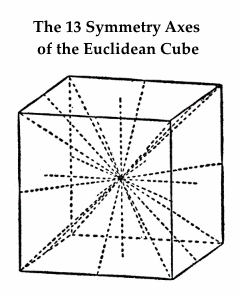

The 3×3×3 Galois Cube
Exercise: Is there any such analogy between the 31 points of the
order-5 Galois projective plane and the 31 symmetry axes of the
Euclidean dodecahedron and icosahedron? Also, how may the
31 projective points be naturally pictured as lines within the
5x5x5 Galois cube (vector 3-space over GF(5))?
Update of Nov. 30, 2014 —
For background to the above exercise, see
pp. 16-17 of A Geometrical Picture Book ,
by Burkard Polster (Springer, 1998), esp.
the citation to a 1983 article by Lemay.
Monday, October 6, 2014
Reviews
From the MacTutor biography of Otto Neugebauer:
“… two projects which would be among the most important
contributions anyone has made to mathematics. He persuaded
Springer-Verlag to publish a journal reviewing all mathematical
publications, which would complement their reviewing journals
in other topics. In 1931 the first issue of Zentralblatt für Matematik
appeared, edited by Neugebauer.” [Mathematical Reviews was
the other project.]
Neugebauer appeared in Sunday morning’s post In Nomine Patris .
A review from Zentralblatt appeared in the Story Creep link from
this morning’s post Mysterious Correspondences.
Saturday, September 20, 2014
The Metaphysics of Entities
Anthony Lane in The New Yorker , issue dated Sept. 22, 2014:
"The hero of 'The Zero Theorem' is a computer genius called Qohen Leth
(Christoph Waltz)…. He is the sole resident of a derelict church, where,
on a crucifix in front of the altar, the head of Christ has been replaced by
a security camera. No prayers are ever said, and none are answered.
In short, the place is deconsecrated, but to claim that it lacks any spark of
sacred yearning would be wrong, because Qohen devotes his days to seeking
the Zero Theorem, which—whatever it may be—lies at the fuzzy limit of
human powers. “We crunch entities,” he says, as if that explained anything.
His employer is Mancom, a large corporation that, in Orwellian fashion,
oversees ordinary lives, although it betrays more frantic desperation than
glowering threat."
One approach to the metaphysics of entities was indicated in the previous
post, 'Metaphysics for Gilliam." A different approach:
"Categories, Sets, and the Nature of Mathematical Entities,"
by Jean-Pierre Marquis, Ch. 13, pp. 181-192, in the 2006 book
The Age of Alternative Logics , ed. by van Benthem et al.
(Springer, Netherlands).
From pages 182-183 —
13.2 The nature of mathematical entities
Let us start with the nature of mathematical entities in general and with a
rough and classical distinction that will simply set the stage for the picture we
want to develop. We essentially follow Lowe 1998* for the basic distinctions. We
need to distinguish between abstract and concrete entities, on the one hand, and
universals and particulars on the other hand. For our purpose, it is not necessary
to specify a criterion of demarcation between abstract and concrete entities. We
simply assume that such a distinction can be made, e.g. concrete entities can
change whereas abstract entities cannot. We assume that a universal is an entity
that can be instantiated by entities which themselves are not instantiable, the
latter being of course particulars. Given these distinctions, an entity can be a
concrete particular, a concrete universal, an abstract particular or an abstract
universal.
Our focus here is between the last two possibilities. For we claim that the
current conception of sets makes them abstract particulars whereas for objects
defined within categories, mathematical entities are abstract universals. This,
we claim, is true of category theory as it is.
* Lowe, E.J., 1998, The Possibility of Metaphysics , Oxford: Clarendon Press.
Wednesday, September 17, 2014
The Horse
A New York Times piece today on author Donald Antrim:
“The next project is a novel ‘about’ (having loosely to do with)
his father, Harry, a T. S. Eliot scholar who wrote a well-regarded
monograph on the poet.”
— John Jeremiah Sullivan
From Harry T. Antrim’s 1967 thesis on Eliot:
“That words can be made to reach across the void
left by the disappearance of God (and hence of all
Absolutes) and thereby reestablish some basis of
relation with forms existing outside the subjective
and ego-centered self has been one of the chief
concerns of the first half of the twentieth century.”
An epigraph selected by Sullivan for a 2002 Harper’s Magazine
article, “Horseman, Pass By“—
Far back, far back in our dark soul
the horse prances.
— D. H. Lawrence
A related image from pure mathematics
(a source of Absolutes unrelated to theology):

See April 9, 2004, for a post on the “Horseman” article.
Sunday, August 31, 2014
Sunday School
The Folding
Cynthia Zarin in The New Yorker , issue dated April 12, 2004—
“Time, for L’Engle, is accordion-pleated. She elaborated,
‘When you bring a sheet off the line, you can’t handle it
until it’s folded, and in a sense, I think, the universe can’t
exist until it’s folded — or it’s a story without a book.’”
The geometry of the 4×4 square array is that of the
3-dimensional projective Galois space PG(3,2).
This space occurs, notably, in the Miracle Octad Generator (MOG)
of R. T. Curtis (submitted to Math. Proc. Camb. Phil. Soc. on
15 June 1974). Curtis did not, however, describe its geometric
properties. For these, see the Cullinane diamond theorem.
Some history:
Curtis seems to have obtained the 4×4 space by permuting,
then “folding” 1×8 binary sequences into 4×2 binary arrays.
The original 1×8 sequences came from the method of Turyn
(1967) described by van Lint in his book Coding Theory
(Springer Lecture Notes in Mathematics, No. 201 , first edition
published in 1971). Two 4×2 arrays form each 4×4 square array
within the MOG. This construction did not suggest any discussion
of the geometric properties of the square arrays.
[Rewritten for clarity on Sept. 3, 2014.]
Monday, August 11, 2014
Syntactic/Symplectic
(Continued from August 9, 2014.)
Syntactic:
Symplectic:
"Visual forms— lines, colors, proportions, etc.— are just as capable of
articulation , i.e. of complex combination, as words. But the laws that govern
this sort of articulation are altogether different from the laws of syntax that
govern language. The most radical difference is that visual forms are not
discursive . They do not present their constituents successively, but
simultaneously, so the relations determining a visual structure are grasped
in one act of vision."
– Susanne K. Langer, Philosophy in a New Key
For examples, see The Diamond-Theorem Correlation
in Rosenhain and Göpel Tetrads in PG(3,2).
This is a symplectic correlation,* constructed using the following
visual structure:
 .
.
* Defined in (for instance) Paul B. Yale, Geometry and Symmetry ,
Holden-Day, 1968, sections 6.9 and 6.10.
Sunday, August 10, 2014
Knight Moves
Some illustrations:
Chess Knight
(in German, Springer)
See also…
More technically (click image for details):
Sermon
From The Mathematics of Language:
10th and 11th Biennial Conference….
Berlin, Springer, 2010 —
“Creation Myths of Generative Grammar
and the Mathematics of Syntactic Structures”
by Geoffrey K. Pullum, University of Edinburgh
Abstract
“Syntactic Structures (Chomsky [6]) is widely believed to have laid
the foundations of a cognitive revolution in linguistic science, and
to have presented (i) the first use in linguistics of powerful new ideas
regarding grammars as generative systems, (ii) a proof that English
was not a regular language, (iii) decisive syntactic arguments against
context-free phrase structure grammar description, and (iv) a
demonstration of how transformational rules could provide a formal
solution to those problems. None of these things are true. This paper
offers a retrospective analysis and evaluation.”
Tuesday, February 18, 2014
Eichler’s Reciprocity Law
Edward Frenkel on Eichler's reciprocity law
(Love and Math , Kindle edition of 2013-10-01,
page 88, location 1812)—
"It seems nearly unbelievable that there
would be a rule generating these numbers.
And yet, German mathematician Martin
Eichler discovered one in 1954.11 "
"11. I follow the presentation of this result
given in Richard Taylor, Modular arithmetic:
driven by inherent beauty and human
curiosity , The Letter of the Institute for
Advanced Study [IAS], Summer 2012,
pp. 6– 8. I thank Ken Ribet for useful
comments. According to André Weil’s book
Dirichlet Series and Automorphic Forms ,
Springer-Verlag, 1971 [pp. 143-144], the
cubic equation we are discussing in this
chapter was introduced by John Tate,
following Robert Fricke."
|
Update of Feb. 19:
Actually, the cubic equation discussed Y 2 + Y = X 3 – X 2
whereas the equation given by Weil, Y 2 – Y = X 3 – X 2 .
Whether this is a misprint in Weil's book,
At any rate, the cubic equation discussed by
For further background, see (for instance) |
Richard Taylor, op. cit. —
|
One could ask for a similar method that given any number of polynomials in any number of variables helps one to determine the number of solutions to those equations in arithmetic modulo a variable prime number p . Such results are referred to as “reciprocity laws.” In the 1920s, Emil Artin gave what was then thought to be the most general reciprocity law possible—his abelian reciprocity law. However, Artin’s reciprocity still only applied to very special equations—equations with only one variable that have “abelian Galois group.” Stunningly, in 1954, Martin Eichler (former IAS Member) found a totally new reciprocity law, not included in Artin’s theorem. (Such reciprocity laws are often referred to as non-abelian.) More specifically, he found a reciprocality [sic ] law for the two variable equation Y 2 + Y = X 3 – X 2. He showed that the number of solutions to this equation in arithmetic modulo a prime number p differs from p [in the negative direction] by the coefficient of q p in the formal (infinite) product
q (1 – q 2 )(1 – q 11) 2 (1 – q 2)2 For example, you see that the coefficient of q5 is 1, so Eichler’s theorem tells us that Y 2 + Y = X 3 − X 2 should have 5 − 1 = 4 solutions in arithmetic modulo 5. You can check this by checking the twenty-five possibilities for (X,Y) modulo 5, and indeed you will find exactly four solutions: (X,Y) ≡ (0,0), (0,4), (1,0), (1,4) mod 5. Within less than three years, Yutaka Taniyama and Goro Shimura (former IAS Member) proposed a daring generalization of Eichler’s reciprocity law to all cubic equations in two variables. A decade later, André Weil (former IAS Professor) added precision to this conjecture, and found strong heuristic evidence supporting the Shimura-Taniyama reciprocity law. This conjecture completely changed the development of number theory. |
With this account and its context, Taylor has
perhaps atoned for his ridiculous remarks
quoted at Log24 in The Proof and the Lie.
Monday, October 21, 2013
Edifice Complex
New! Improved!
"Euclid's edifice loomed in my consciousness
as a marvel among sciences, unique in its
clarity and unquestionable validity."
—Richard J. Trudeau in
The Non-Euclidean Revolution (First published in 1986)
Readers of this journal will be aware that Springer's new page
advertising Trudeau's book, pictured above, is a bait-and-switch
operation. In the chapter advertised, Trudeau promotes what he
calls "the Diamond Theory of Truth" as a setup for his real goal,
which he calls "the Story Theory of Truth."
For an earlier use of the phrase "Diamond Theory" in
connection with geometry, see a publication from 1977.
Tuesday, February 19, 2013
Configurations
Yesterday's post Permanence dealt with the cube
as a symmetric model of the finite projective plane
PG(2,3), which has 13 points and 13 lines. The points
and lines of the finite geometry occur in the cube as
the 13 axes of symmetry and the 13 planes through
the center perpendicular to those axes. If the three
axes lying in a plane that cuts the cube in a hexagon
are supplemented by the axis perpendicular to that
plane, each plane is associated with four axes and,
dually, each axis is associated with four planes.
My web page on this topic, Cubist Geometries, was
written on February 27, 2010, and first saved to the
Internet Archive on Oct. 4, 2010.
For a more recent treatment of this topic that makes
exactly the same points as the 2010 page, see p. 218
of Configurations from a Graphical Viewpoint , by
Tomaž Pisanski and Brigitte Servatius, published by
Springer on Sept. 23, 2012 (date from both Google
Books and Amazon.com):
For a similar 1998 treatment of the topic, see Burkard Polster's
A Geometrical Picture Book (Springer, 1998), pp. 103-104.
The Pisanski-Servatius book reinforces my argument of Jan. 13, 2013,
that the 13 planes through the cube's center that are perpendicular
to the 13 axes of symmetry of the cube should be called the cube's
symmetry planes , contradicting the usual use of of that term.
That argument concerns the interplay between Euclidean and
Galois geometry. Pisanski and Servatius (and, in 1998, Polster)
emphasize the Euclidean square and cube as guides* to
describing the structure of a Galois space. My Jan. 13 argument
uses Galois structures as a guide to re-describing those of Euclid .
(For a similar strategy at a much more sophisticated level,
see a recent Harvard Math Table.)
Related material: Remarks on configurations in this journal
during the month that saw publication of the Pisanski-Servatius book.
* Earlier guides: the diamond theorem (1978), similar theorems for
2x2x2 (1984) and 4x4x4 cubes (1983), and Visualizing GL(2,p)
(1985). See also Spaces as Hypercubes (2012).
Sunday, October 14, 2012
Crossroads
"Mathematics is not the rigid and petrifying schema, as the layman so much likes to view it; with it, we rather stand precisely at the point of intersection of restraint and freedom that makes up the essence of man itself."
— A translated remark by Hermann Weyl, p. 136, "The Current Epistemogical Situation in Mathematics" in Paolo Mancosu (ed.) From Brouwer to Hilbert. The Debate on the Foundations of Mathematics in the 1920s , Oxford University Press, 1998, pp. 123-142, as cited by David Corfield
Corfield once wrote that he would like to know the original German of Weyl's remark. Here it is:
"Die Mathematik ist nicht das starre und Erstarrung bringende Schema, als das der Laie sie so gerne ansieht; sondern wir stehen mit ihr genau in jenem Schnittpunkt von Gebundenheit und Freiheit, welcher das Wesen des Menschen selbst ist."
— Hermann Weyl, page 533 of "Die heutige Erkenntnislage in der Mathematik" (Symposion 1, 1-32, 1925), reprinted in Gesammelte Abhandlungen, Band II (Springer, 1968), pages 511-542
For some context, see a post of January 23, 2006.
Monday, August 27, 2012
Touchy-Feely
A remark by the late William P. Thurston—
Please note: I'm not advocating that
we turn mathematics into a touchy-feely subject.
Noted. But see this passage—
|
The Mathematical Experience , by Philip J. Davis and Reuben Hersh (1981), updated study edition, Springer, 2011— From the section titled "Four-Dimensional Intuition," pages 445-446: "At Brown University Thomas Banchoff, a mathematician, and Charles Strauss, a computer scientist, have made computer-generated motion pictures of a hypercube…. … at the Brown University Computing Center, Strauss gave me a demonstration of the interactive graphic system which made it possible to produce such a film…. … Strauss showed me how all these controls could be used to get various views of three-dimensional projections of a hypercube. I watched, and tried my best to grasp what I was looking at. Then he stood up, and offered me the chair at the control. I tried turning the hypercube around, moving it away, bringing it up close, turning it around another way. Suddenly I could feel it!. The hypercube had leaped into palpable reality, as I learned how to manipulate it, feeling in my fingertips the power to change what I saw and change it back again. The active control at the computer console created a union of kinesthetics and visual thinking which brought the hypercube up to the level of intuitive understanding." |
Thanks to the Web, a version of this experience created by Harry J. Smith
has been available to non-academics for some time.

Sunday, July 29, 2012
The Galois Tesseract
The three parts of the figure in today's earlier post "Defining Form"—

— share the same vector-space structure:
| 0 | c | d | c + d |
| a | a + c | a + d | a + c + d |
| b | b + c | b + d | b + c + d |
| a + b | a + b + c | a + b + d | a + b + c + d |
(This vector-space a b c d diagram is from Chapter 11 of
Sphere Packings, Lattices and Groups , by John Horton
Conway and N. J. A. Sloane, first published by Springer
in 1988.)
The fact that any 4×4 array embodies such a structure was implicit in
the diamond theorem (February 1979). Any 4×4 array, regarded as
a model of the finite geometry AG(4, 2), may be called a Galois tesseract.
(So called because of the Galois geometry involved, and because the
16 cells of a 4×4 array with opposite edges identified have the same
adjacency pattern as the 16 vertices of a tesseract (see, for instance,
Coxeter's 1950 "Self-Dual Configurations and Regular Graphs," figures
5 and 6).)
A 1982 discussion of a more abstract form of AG(4, 2):

Source:

The above 1982 remarks by Brouwer may or may not have influenced
the drawing of the above 1988 Conway-Sloane diagram.
Monday, July 16, 2012
Mapping Problem continued
Another approach to the square-to-triangle
mapping problem (see also previous post)—

For the square model referred to in the above picture, see (for instance)
- Picturing the Smallest Projective 3-Space,
- The Relativity Problem in Finite Geometry, and
- Symmetry of Walsh Functions.
Coordinates for the 16 points in the triangular arrays
of the corresponding affine space may be deduced
from the patterns in the projective-hyperplanes array above.
This should solve the inverse problem of mapping,
in a natural way, the triangular array of 16 points
to the square array of 16 points.
Update of 9:35 AM ET July 16, 2012:
Note that the square model's 15 hyperplanes S
and the triangular model's 15 hyperplanes T —

— share the following vector-space structure —
| 0 | c | d | c + d |
| a | a + c | a + d | a + c + d |
| b | b + c | b + d | b + c + d |
| a + b | a + b + c | a + b + d | a + b + c + d |
(This vector-space a b c d diagram is from
Chapter 11 of Sphere Packings, Lattices
and Groups , by John Horton Conway and
N. J. A. Sloane, first published by Springer
in 1988.)
Wednesday, May 30, 2012
Professing
The "New Books" link in today's Arts & Letters Daily leads to a review of Andrew Delbanco's College: What it Was, Is, and Should
Some, like Delbanco, remind us what the word ‘professor’ once meant: ‘A person who professes a faith, as in the Puritan churches, where the profession was made before the congregation as a kind of public initiation.’
I am not now, nor have I ever been, a professor.
I did, however, once profess the following:
This 1988 letter advocated viewing pure mathematics as one of the liberal arts. Twenty-four years later, that position still seems worth defending.
Arithmetic (i.e., number theory) and geometry are, by the way, two of the seven traditional liberal arts.
Tuesday, May 29, 2012
The Shining of May 29
(Continued from May 29, 2002)
May 29, 1832—
Évariste Galois, Lettre de Galois à M. Auguste Chevalier—
Après cela, il se trouvera, j'espère, des gens qui trouveront leur profit à déchiffrer tout ce gâchis.
(Later there will be, I hope, some people who will find it to their advantage to decipher all this mess.)
Martin Gardner on the above letter—
"Galois had written several articles on group theory, and was merely annotating and correcting those earlier published papers."
– The Last Recreations , by Martin Gardner, published by Springer in 2007, page 156.
Commentary from Dec. 2011 on Gardner's word "published" —
Monday, May 28, 2012
Fundamental Dichotomy
Jamie James in The Music of the Spheres
(Springer paperback, 1995), page 28—
Pythagoras constructed a table of opposites
from which he was able to derive every concept
needed for a philosophy of the phenomenal world.
As reconstructed by Aristotle in his Metaphysics,
the table contains ten dualities….
|
Limited |
Unlimited |
Of these dualities, the first is the most important;
all the others may be seen as different aspects
of this fundamental dichotomy.
For further information, search on peiron + apeiron or
consult, say, Ancient Greek Philosophy , by Vijay Tankha.
The limited-unlimited contrast is not unrelated to the
contrasts between
Saturday, May 26, 2012
Harriot’s Cubes

See also Finite Geometry and Physical Space.
Related material from MacTutor—
The paper by J. W. Shirley, Binary numeration before Leibniz, Amer. J. Physics 19 (8) (1951), 452-454, contains an interesting look at some mathematics which appears in the hand written papers of Thomas Harriot [1560-1621]. Using the photographs of the two original Harriot manuscript pages reproduced in Shirley’s paper, we explain how Harriot was doing arithmetic with binary numbers. Leibniz [1646-1716] is credited with the invention [1679-1703] of binary arithmetic, that is arithmetic using base 2. Laplace wrote:-
However, Leibniz was certainly not the first person to think of doing arithmetic using numbers to base 2. Many years earlier Harriot had experimented with the idea of different number bases…. |
For a discussion of Harriot on the discrete-vs.-continuous question,
see Katherine Neal, From Discrete to Continuous: The Broadening
of Number Concepts in Early Modern England (Springer, 2002),
pages 69-71.
Tuesday, May 1, 2012
What is Truth? (continued)
"There is a pleasantly discursive treatment of
Pontius Pilate's unanswered question 'What is truth?'"
— H. S. M. Coxeter, 1987
Returning to the Walpurgisnacht posts
Decomposition (continued) and
Decomposition– Part III —
Some further background…
SAT
(Not a Scholastic Aptitude Test)
"In computer science, satisfiability (often written
in all capitals or abbreviated SAT) is the problem
of determining if the variables of a given Boolean
formula can be assigned in such a way as to
make the formula evaluate to TRUE."
— Wikipedia article Boolean satisfiability problem
For the relationship of logic decomposition to SAT,
see (for instance) these topics in the introduction to—
Advanced Techniques in Logic Synthesis,
Optimizations and Applications* —
Click image for a synopsis.
* Edited by Sunil P. Khatri and Kanupriya Gulati
Wednesday, March 21, 2012
Square-Triangle Theorem
(Continued from March 18, 2012)
Found in a search this evening—
How Does One Cut a Triangle? by Alexander Soifer
(Second edition, Springer, 2009. First edition published
by Soifer's Center for Excellence in Mathematical Education,
Colorado Springs, CO, in 1990.)
This book, of xxx + 174 pages, covers questions closely related
to the "square-triangle" result I published in a letter to the
editor of the June-July 1985 American Mathematical Monthly
(Vol. 92, No. 6, p. 443). See Square-Triangle Theorem.
Soifer's four pages of references include neither that letter
nor the Monthly item, "Miscellaneum 129: Triangles are square"
of a year earlier that prompted the letter.
Friday, February 10, 2012
24 Hour Psycho
From "Kill Bill: Vol. 1"—
The Bride: [Japanese] I need Japanese steel.
Related material —
Yodogawa, 1982 (see yesterday evening's Psycho) and…
See also this afternoon's 5:01 post.
Thursday, February 9, 2012
ART WARS continued
On the Complexity of Combat—
The above article (see original pdf), clearly of more
theoretical than practical interest, uses the concept
of "symmetropy" developed by some Japanese
researchers.
For some background from finite geometry, see
Symmetry of Walsh Functions. For related posts
in this journal, see Smallest Perfect Universe.
Update of 7:00 PM EST Feb. 9, 2012—
Background on Walsh-function symmetry in 1982—
(Click image to enlarge. See also original pdf.)
Note the somewhat confusing resemblance to
a four-color decomposition theorem
used in the proof of the diamond theorem.
Friday, January 20, 2012
Chess
| Saturday, November 12, 2005
— m759 @ 8:00 PM (continued)
“… problems are the poetry of chess. |
Saturday, January 7, 2012
Fearful Cold Intelligence
"Dreams are sleep's watchful brother, of death's fraternity,
heralds, watchmen of that coming night, and our attitude
toward them may be modeled upon Hades, receiving, hospitable,
yet relentlessly deepening, attuned to the nocturne, dusky, and
with a fearful cold intelligence that gives permanent shelter
in his house to the incurable conditions of human being."
— James Hillman, conclusion of
The Dream and the Underworld (Harper & Row, 1979)
In memory of Raymond Edward Alan Christopher Paley—
Related material— Mathieu Symmetry.
Saturday, November 26, 2011
Innermost Kernel (continued*)
A search on the word "innermost" in a PDF copy of a book
by Suzanne Gieser on Jung and Pauli yields no definite meaning
for the book's title, The Innermost Kernel (Springer, 2005).
The author does, however, devote a section (pp. 36-41) to the
influence of Schopenhauer on Jung and Pauli, and that section at least
suggests that the historical origin of her title is in Schopenhauer's
reformulation of Kant's "Ding an sich."
The Innermost Kernel , p. 37—
"… an expression of an underlying invisible world,
the one that forms the innermost essence of reality,
the thing-in-itself. This is the will, a blind existence
that forms an omnipresent entity beyond time, space
and individuality." *
* Arthur Schopenhauer, "Über die Vierfache Wurzel
des Satzes vom zureichenden Grunde" (1813),
Kleinere Schriften, SämtlicheWerke III
(Stuttgart, 1962), 805–806.
* See also Mann on Schopenhauer and an "innermost kernel."
Tuesday, November 22, 2011
Serious
Today's New York Lottery numbers:
Continuing the Serious Hardy Apology sequence,
here is a reference to volume number 231 in the
Springer Graduate Texts in Mathematics series—
For some less serious work, see posts on 4403 (4/4/03)
as well as posts numbered 550 and 764.
Wednesday, October 26, 2011
Erlanger and Galois
Peter J. Cameron yesterday on Galois—
"He was killed in a duel at the age of 20…. His work languished for another 14 years until Liouville published it in his Journal; soon it was recognised as the foundation stone of modern algebra, a position it has never lost."
Here Cameron is discussing Galois theory, a part of algebra. Galois is known also as the founder* of group theory, a more general subject.
Group theory is an essential part of modern geometry as well as of modern algebra—
"In der Galois'schen Theorie, wie hier, concentrirt sich das Interesse auf Gruppen von Änderungen. Die Objecte, auf welche sich die Änderungen beziehen, sind allerdings verschieden; man hat es dort mit einer endlichen Zahl discreter Elemente, hier mit der unendlichen Zahl von Elementen einer stetigen Mannigfaltigkeit zu thun."
— Felix Christian Klein, Erlanger Programm , 1872
("In the Galois theory, as in ours, the interest centres on groups of transformations. The objects to which the transformations are applied are indeed different; there we have to do with a finite number of discrete elements, here with the infinite number of elements in a continuous manifoldness." (Translated by M.W. Haskell, published in Bull. New York Math. Soc. 2, (1892-1893), 215-249))
Related material from Hermann Weyl, Symmetry , Princeton University Press, 1952 (paperback reprint of 1982, pp. 143-144)—
"A field is perhaps the simplest algebraic structure we can invent. Its elements are numbers…. Space is another example of an entity endowed with a structure. Here the elements are points…. What we learn from our whole discussion and what has indeed become a guiding principle in modern mathematics is this lesson: Whenever you have to do with a structure-endowed entity Σ try to determine is group of automorphisms , the group of those element-wise transformations which leave all structural relations undisturbed. You can expect to gain a deep insight into the constitution of Σ in this way."
For a simple example of a group acting on a field (of 8 elements) that is also a space (of 8 points), see Generating the Octad Generator and Knight Moves.
* Joseph J. Rotman, An Introduction to the Theory of Groups , 4th ed., Springer, 1994, page 2
Sunday, August 7, 2011
Reflection Group
The European Reflection Group report of Saturday, May 8, 2010—
"Project Europe 2030: Challenges and Opportunities" (pdf, 46 pp.)—
"All our members agree on one fundamental issue:
Europe is currently at a turning point in its history."
This journal on the same date— "A Better Story"—
"…I can imagine the decisive evolutionary beginnings of humans and societies… not in an adult version, but in the playful mentality of children…. An unlikely story? Perhaps. I am looking out for a better story."
– Hans G. Furth, Desire for Society: Children's Knowledge as Social Imagination, published by Springer, 1996, p. 181
"The clocks were striking thirteen." — George Orwell
See also this journal during the rest of May 2010 and "Sermon" from Sunday, February 20, 2011.
Saturday, August 6, 2011
Correspondences
Comme de longs échos qui de loin se confondent
Dans une ténébreuse et profonde unité….
— Baudelaire, “Correspondances ”
From “A Four-Color Theorem”—

Figure 1
Note that this illustrates a natural correspondence
between
(A) the seven highly symmetrical four-colorings
of the 4×2 array at the left of Fig. 1, and
(B) the seven points of the smallest
projective plane at the right of Fig. 1.
To see the correspondence, add, in binary
fashion, the pairs of projective points from the
“points” section that correspond to like-colored
squares in a four-coloring from the left of Fig. 1.
(The correspondence can, of course, be described
in terms of cosets rather than of colorings.)
A different correspondence between these 7 four-coloring
structures and these 7 projective-line structures appears in
a structural analysis of the Miracle Octad Generator
(MOG) of R.T. Curtis—

Figure 2
| Here the correspondence between the 7 four-coloring structures (left section) and the 7 projective-line structures (center section) is less obvious, but more fruitful. It yields, as shown, all of the 35 partitions of an 8-element set (an 8-set ) into two 4-sets. The 7 four-colorings in Fig. 2 also appear in the 35 4×4 parts of the MOG that correspond, in a way indicated by Fig. 2, to the 35 8-set paritions. This larger correspondence— of 35 4×2 arrays with 35 4×4 arrays— is the MOG, at least as it was originally defined. See The MOG, Generating the Octad Generator, and Eightfold Geometry.
For some applications of the Curtis MOG, see |
Wednesday, July 6, 2011
Nordstrom-Robinson Automorphisms
A 2008 statement on the order of the automorphism group of the Nordstrom-Robinson code—
"The Nordstrom-Robinson code has an unusually large group of automorphisms (of order 8! = 40,320) and is optimal in many respects. It can be found inside the binary Golay code."
— Jürgen Bierbrauer and Jessica Fridrich, preprint of "Constructing Good Covering Codes for Applications in Steganography," Transactions on Data Hiding and Multimedia Security III, Springer Lecture Notes in Computer Science, 2008, Volume 4920/2008, 1-22
A statement by Bierbrauer from 2004 has an error that doubles the above figure—
The automorphism group of the binary Golay code G is the simple Mathieu group M24 of order
— Jürgen Bierbrauer, "Nordstrom-Robinson Code and A7-Geometry," preprint dated April 14, 2004, published in Finite Fields and Their Applications , Volume 13, Issue 1, January 2007, Pages 158-170
The error is corrected (though not detected) later in the same 2004 paper—
In fact the symmetry group of the octacode is a semidirect product of an elementary abelian group of order 16 and the simple group GL(3, 2) of order 168. This constitutes a large automorphism group (of order 2688), but the automorphism group of NR is larger yet as we saw earlier (order 40,320).
For some background, see a well-known construction of the code from the Miracle Octad Generator of R.T. Curtis—
For some context, see the group of order 322,560 in Geometry of the 4×4 Square.
Wednesday, June 15, 2011
A for Anastasios
The title was suggested by this evening's 4-digit NY lottery number.
"… the rhetoric might be a bit over the top."

According to Amazon.com, 2198 (i.e., 2/1/98) was the publication
date of Geometry of Vector Sheaves , Volume I, by Anastasios Mallios.
Related material—
The question of S.S. Chern quoted here June 10: —
"What is Geometry?"— and the remark by Stevens that
accompanied the quotation—
"Reality is the beginning not the end,
Naked Alpha, not the hierophant Omega,
of dense investiture, with luminous vassals."
— Wallace Stevens,
“An Ordinary Evening in New Haven” VI
The work of Mallios in pure mathematics cited above seems
quite respectable (unlike his later remarks on physics).
His Vector Sheaves appears to be trying to explore new territory;
hence the relevance of Stevens's "Alpha." See also the phrase
"A-Invariance" in an undated preprint by Mallios*.
For the evening 3-digit number, 533, see a Stevens poem—

This meditation by Stevens is related to the female form of Mallios's Christian name.
As for the afternoon numbers, see "62" in The Beauty Test (May 23, 2007), Geometry and Death, and "9181" as the date 9/1/81.
* Later published in International Journal of Theoretical Physics , Vol. 47, No. 7, cover date 2008-07-01
Friday, March 18, 2011
Defining Configurations*
The On-Line Encyclopedia of Integer Sequences has an article titled "Number of combinatorial configurations of type (n_3)," by N.J.A. Sloane and D. Glynn.
From that article:
- DEFINITION: A combinatorial configuration of type (n_3) consists of an (abstract) set of n points together with a set of n triples of points, called lines, such that each point belongs to 3 lines and each line contains 3 points.
- EXAMPLE: The unique (8_3) configuration consists of the triples 125, 148, 167, 236, 278, 347, 358, 456.
The following corrects the word "unique" in the example.

* This post corrects an earlier post, also numbered 14660 and dated 7 PM March 18, 2011, that was in error.
The correction was made at about 11:50 AM on March 20, 2011.
_____________________________________________________________
Update of March 21
The problem here is of course with the definition. Sloane and Glynn failed to include in their definition a condition that is common in other definitions of configurations, even abstract or purely "combinatorial" configurations. See, for instance, Configurations of Points and Lines , by Branko Grunbaum (American Mathematical Society, 2009), p. 17—
In the most general sense we shall consider combinatorial (or abstract) configurations; we shall use the term set-configurations as well. In this setting "points" are interpreted as any symbols (usually letters or integers), and "lines" are families of such symbols; "incidence" means that a "point" is an element of a "line". It follows that combinatorial configurations are special kinds of general incidence structures. Occasionally, in order to simplify and clarify the language, for "points" we shall use the term marks, and for "lines" we shall use blocks. The main property of geometric configurations that is preserved in the generalization to set-configurations (and that characterizes such configurations) is that two marks are incident with at most one block, and two blocks with at most one mark.
Whether or not omitting this "at most one" condition from the definition is aesthetically the best choice, it dramatically changes the number of configurations in the resulting theory, as the above (8_3) examples show.
Update of March 22 (itself updated on March 25)
For further background on configurations, see Dolgachev—

Note that the two examples Dolgachev mentions here, with 16 points and 9 points, are not unrelated to the geometry of 4×4 and 3×3 square arrays. For the Kummer and related 16-point configurations, see section 10.3, "The Three Biplanes of Order 4," in Burkard Polster's A Geometrical Picture Book (Springer, 1998). See also the 4×4 array described by Gordon Royle in an undated web page and in 1980 by Assmus and Sardi. For the Hesse configuration, see (for instance) the passage from Coxeter quoted in Quaternions in an Affine Galois Plane.
Update of March 27
See the above link to the (16,6) 4×4 array and the (16,6) exercises using this array in R.D. Carmichael's classic Introduction to the Theory of Groups of Finite Order (1937), pp. 42-43. For a connection of this sort of 4×4 geometry to the geometry of the diamond theorem, read "The 2-subsets of a 6-set are the points of a PG(3,2)" (a note from 1986) in light of R.W.H.T. Hudson's 1905 classic Kummer's Quartic Surface , pages 8-9, 16-17, 44-45, 76-77, 78-79, and 80.
Saturday, December 18, 2010
Friday, November 26, 2010
Making a Play
From "Deus ex Machina and the Aesthetics of Proof"
(Alan J. Cain in The Mathematical Intelligencer * of September 2010, pdf)—
Deus ex Machina
In a narrative, a deus is unsatisfying for two reasons. The
first is that any future attempt to build tension is undercut if
the author establishes that a difficulty can be resolved by a
deus. The second reason—more important for the purposes
of this essay—is that the deus does not fit with the internal
structure of the story. There is no reason internal to the
story why the deus should intervene at that moment.

Santa in the New York Thanksgiving Day Parade
Thanksgiving Day, 2010 (November 25), New York Lottery—
Midday 411, Evening 332.
For 411, see (for instance) April 11 (i.e., 4/11) in 2008 —
For 332, see "A Play for Kristen**" — March 16, 2008 —
"A search for the evening number, 332, in Log24 yields a rather famous line from Sophocles…"
Sophocles, Antigone, edited by Mark Griffith, Cambridge University Press, 1999:

“Many things are formidable (deina ) and none is more formidable (deinoteron ) than man.”
– Antigone , lines 332-333, in Valdis Leinieks, The Plays of Sophokles, John Benjamins Publishing Company, 1982, p. 62
See also the lottery numbers 411 and 332 in this journal on March 22, 2009— "The Storyteller in Chance ."
“… it’s going to be accomplished in steps,
this establishment of the Talented
in the scheme of things.”
— Anne McCaffrey, Radcliffe ’47, To Ride Pegasus
* It seems Santa has delivered an early gift — free online access to all issues of the Intelligencer .
** Teaser headline in the original version at Xanga.com
Saturday, July 24, 2010
Sunday, July 18, 2010
Darkness at Noon
"'A Disappearing Number'… is lucid, dynamic and continuously engaging."
"'All beautiful theorems require a very high degree of economy, unexpectedness and inevitability,' the string-theory* specialist Aninda tells us after elucidating one of Ramanujan’s formulas. That’s not a bad recipe for beautiful theater either…."
Related material:
Hardy is also the play's (apparently uncredited) source of "economy."
"… a very high degree of unexpectedness, combined with inevitability and economy."
— A Mathematician's Apology, §18, by G. H. Hardy, 1940
* For more on string theory and a deus, see Not Even Wrong, July 7, 2010.
Monday, July 12, 2010
Lying Forth
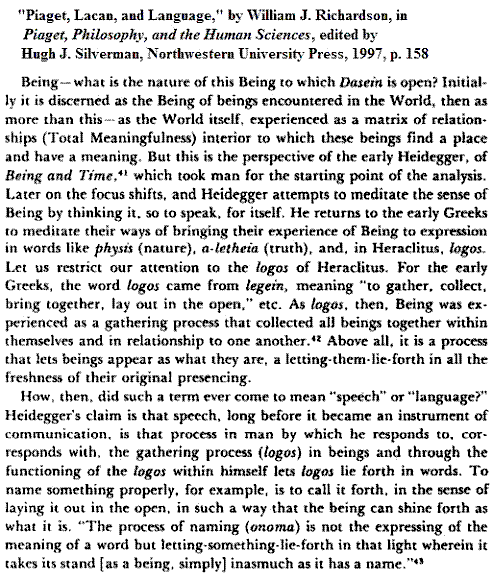
Related material:
Heidegger and Aristotle: The Twofoldness of Being,
by Walter A. Brogan, (SUNY Press, 2005)—
Heidegger: Through Phenomenology to Thought,
by William J. Richardson, S.J., (Springer, 1974)—
Monday, June 7, 2010
Inspirational Combinatorics
According to the Mathematical Association of America this morning, one purpose of the upcoming June/July issue of the Notices of the American Mathematical Society is
"…to stress the inspirational role of combinatorics…."
Here is another contribution along those lines—
Eidetic Variation
from page 244 of
From Combinatorics to Philosophy: The Legacy of G.-C. Rota,
hardcover, published by Springer on August 4, 2009
(Edited by Ernesto Damiani, Ottavio D'Antona, Vincenzo Marra, and Fabrizio Palombi)
"Rota's Philosophical Insights," by Massimo Mugnai—
"… In other words, 'objectivism' is the attitude [that tries] to render a particular aspect absolute and dominant over the others; it is a kind of narrow-mindedness attempting to reduce to only one the multiple layers which constitute what we call 'reality.' According to Rota, this narrow-mindedness limits in an essential way even of [sic ] the most basic facts of our cognitive activity, as, for example, the understanding of a simple declarative sentence: 'So objectivism is the error we [make when we] persist in believing that we can understand what a declarative sentence means without a possible thematization of this declarative sentence in one of [an] endless variety of possible contexts' (Rota, 1991*, p. 155). Rota here implicitly refers to what, amongst phenomenologists is known as eidetic variation, i.e. the change of perspective, imposed by experience or performed voluntarily, from which to look at things, facts or sentences of the world. A typical example, proposed by Heidegger, in Sein und Zeit (1927) and repeated many times by Rota, is that of the hammer."
* Rota, G.-C. (1991), The End of Objectivity: The Legacy of Phenomenology. Lectures at MIT, Cambridge, MA, MIT Mathematics Department
The example of the hammer appears also on yesterday's online New York Times front page—

Related material:
From The Blackwell Dictionary of Western Philosophy—
Eidetic variation — an alternative expression for eidetic reduction
Husserl's term for an intuitive act toward an essence or universal, in contrast to an empirical intuition or perception. He also called this act an essential intuition, eidetic intuition, or eidetic variation. In Greek, eideo means “to see” and what is seen is an eidos (Platonic Form), that is, the common characteristic of a number of entities or regularities in experience. For Plato, eidos means what is seen by the eye of the soul and is identical with essence. Husserl also called this act “ideation,” for ideo is synonymous with eideo and also means “to see” in Greek. Correspondingly, idea is identical to eidos.
An example of eidos— Plato's diamond (from the Meno )—

For examples of variation of this eidos, see the diamond theorem.
See also Blockheads (8/22/08).
Related poetic remarks— The Trials of Device.
Wednesday, June 2, 2010
Rite of Passage
Wikipedia—
"On June 2, Évariste Galois was buried in a common grave of the Montparnasse cemetery whose exact location is unknown."
Évariste Galois, Lettre de Galois à M. Auguste Chevalier—
Après cela, il y aura, j'espère, des gens qui trouveront leur profit à déchiffrer tout ce gâchis.
(Later there will be, I hope, some people who will find it to their advantage to decipher all this mess.)
Martin Gardner on the above letter—
"Galois had written several articles on group theory, and was merely annotating and correcting those earlier published papers."
— The Last Recreations, by Martin Gardner, published by Springer in 2007, page 156.
Sunday, May 9, 2010
Saturday, May 8, 2010
A Better Story —
Or, “Get me rewrite!”
Today’s New York Times online–
Rebecca Newberger Goldstein imagines a story about academics discussing literary theory—
“Rumors had reached us of a doctrine called Theory emanating from distant corners of the university. We in the Department of Philosophy understood it immediately as a grand hoax. I will not dwell on my particular amusement, in which I was so tragically at odds with my collaborator, Theo Rhee….
… It was at this moment that Hans Furth appeared and ambled over….”
And thanks to Google Books, here he is—
“…I can imagine the decisive evolutionary beginnings of humans and societies… not in an adult version, but in the playful mentality of children…. An unlikely story? Perhaps. I am looking out for a better story.”
— Hans G. Furth, Desire for Society: Children’s Knowledge as Social Imagination, published by Springer, 1996, p. 181
As am I. (See previous post.) One possibility, from 1943— “Mimsy Were the Borogoves.”
Another possibility, from 1953— not Theo Rhee, but rather “Loo Ree.”
Saturday, April 10, 2010
Geometry for Generations
"Let G be a finite, primitive subgroup of
— William M. Kantor, "Generation of Linear Groups," pp. 497-509 in The Geometric Vein: The Coxeter Festschrift, published by Springer, 1981
This quote was added today to "A Simple Reflection Group of Order 168."

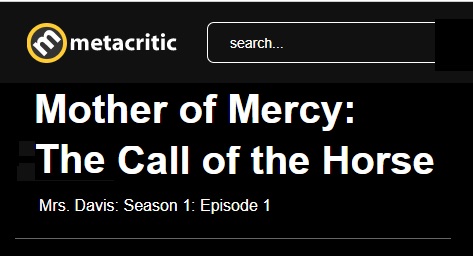






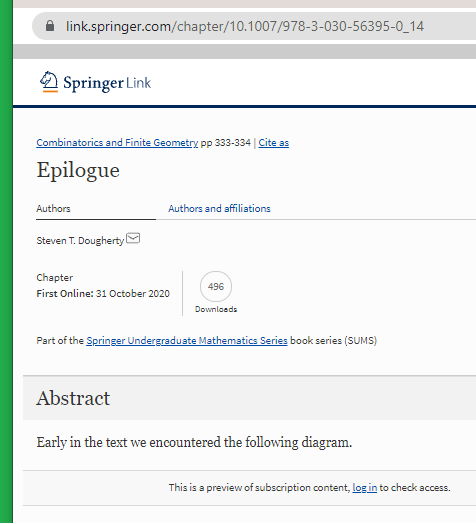



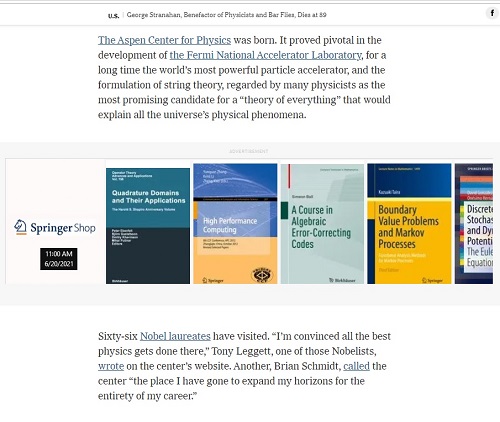































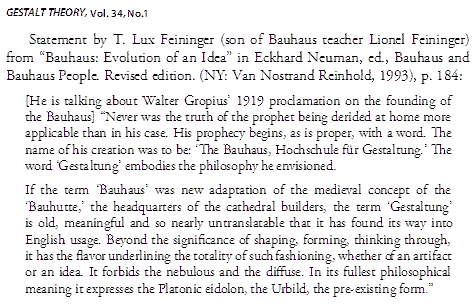







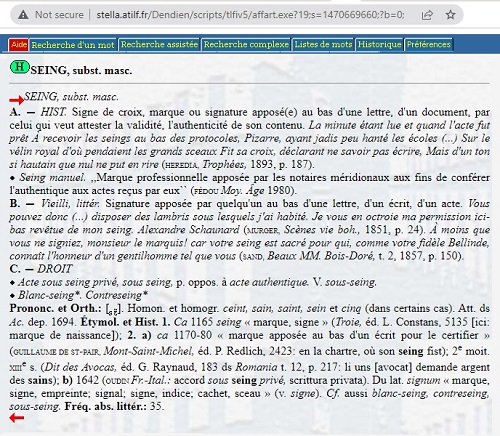
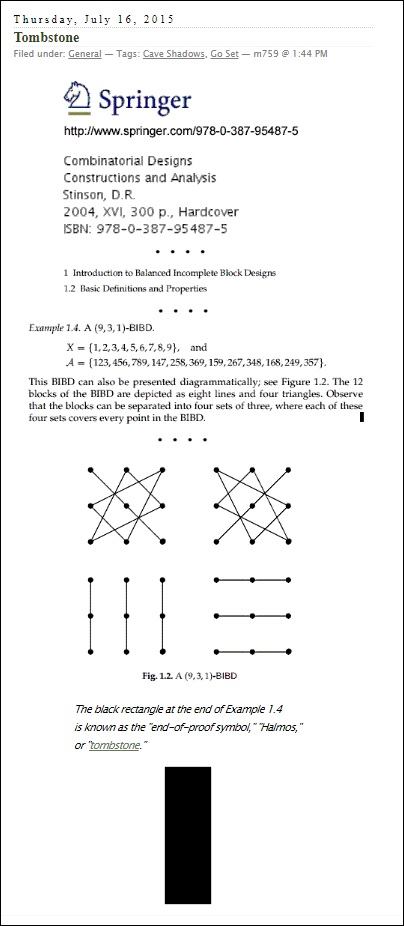


















.gif)










